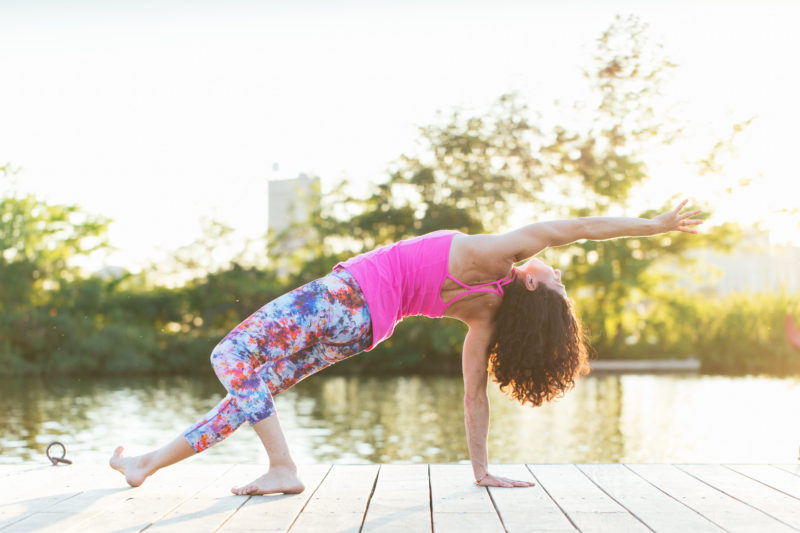
Yoga is a lifetime practice. It’s one of those things that we can consider both a “workout” and a “work IN” referencing its great benefits to both body and mind. However, when the weather gets warmer out, as we’re experiencing now, do you notice your classes get smaller? Do students ask you in a concerned voice before class, “Are you going to turn up the heat?” It’s an understandable concern, especially if you teach yoga in a studio where heated classes are part of the schedule.
First off, it’s helpful to acknowledge the reality: it’s hot out! Sometimes I hear teachers say things like, “Oh, it’s not that hot out!” as if they’re trying to convince the student that it’s not as hot as it is. Of course, everyone is different and you’re idea of “too hot” is different than another student’s idea of “what’s really hot weather” but I’d generally say that once the outside temperature is above 80, it’s a reasonable question for students to ask: “Are you going to add heat in the room?”
So, with that in mind, here are a few ideas to help you when it comes to teaching yoga in the summer months:
Be sure you have a good handle on all the options available to you in terms of both monitoring and altering the room’s temperature. In warmer weather, you may want to run the heat and AC at the same time, or run the fan, or turn off the heat completely. There are lots of factors you can play with to make the room comfortable. Be sure (especially if you’re covering a class in a room or studio where you typically don’t teach) that you know how to work ALL the controls in the room.
Talk to students about their concerns. As I mentioned before, now is not the time to try to play head games with people (“Oh, it’s not THAT hot out!) Hear them out and find out what their concerns are about the temperature. Offer them a different spot in the room that’s not under the heater or by the window. Close the shades. Turn down the lighting a bit. Suggest that if they feel too hot, they step out to the restroom and splash their face with cool water. Make sure they take water breaks. Give them strategies to manage in the heat.
Consider not using any humidifier during class. If it’s really humid out, you’ll be better off adding a little shot of air conditioning every now and then over adding humidity to the room. Talk to students about how your use of AC will clear up the room and make it more breathable than outside. Because of this, they’ll be more comfortable than if they were to go for a run, for instance, because you’re taking out some of that excess moisture in the air and this is of course, impossible, when you’re outside.
Talk to students about the positive effects on the body of the warm weather. You know when you have an injury and the doctor tells you to put a warm compress on the injured area? Well, think about practicing in the warm weather and how the warmth can actually improve your mobility. Talk to students about this and encourage them to stay in tune with their bodies to be sure they’re not going too far or deep in a pose, especially static stretches like Lizard or Low Lunge. However, you might add in some static stretches, encouraging them to stay aware, but giving them a chance to experience how the pose feels in the warmer weather. For those that struggle with tight muscles in the colder weather, they may actually find some relief.
Watch students for signs of over-exertion and overheating. Heat stroke is no joke. Make sure the studio has sports drinks or something with sugar or an additive to add to water in the event a student overheats. Use cold compresses if needed and call 911. In most cases, just keep watching students and adjust both the sequence and room temperature to avoid problems. You can also open the door to the studio to bring in fresh air or even a window if needed.
Talk to the class about the benefits of maintaining a regular practice, even during the summer months. Of course in nice weather, people are going to take advantage of outside activities and exercise. We want to encourage them to do that so to some extent, class sizes may be smaller overall. When you teach, think about addressing the weather in your opening comments to the class (not all the time but perhaps on those really hot days). Thank them for coming and tell them that it’s so wonderful that they’re keeping up with their practice. This acknowledgment is a great way to show them you care and support them in building the healthy habit of a regular practice.
Regardless of the weather, giving effective cues is key when it comes to teaching. Check out my short webinar on effective cues and get the free download with it:
https://barebonesyoga.lpages.co/free-webinar-on-yoga-cues/
Thanks for reading and please leave a comment below!
** Post updated 7/6/19
